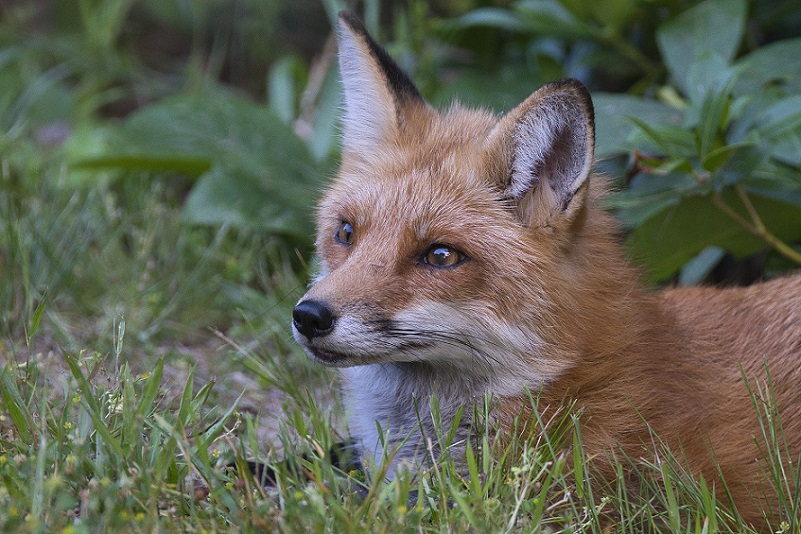The Wonderful World of Wildlife in Prince William County Parks!

From birds, butterflies and deer, to river otters, snakes, foxes and raccoons, these are just some of the wildlife you may come across as you’re out enjoying our parks in Prince William County. The deciduous forest regions in the county make for a wide array of interesting "neighbors" for us to enjoy.
“Where I’m working that day (east, central, or west end of county) can dictate the wildlife I will see,” says Park Ranger, Emma McCarthy. “A few animals I see (or hear!) in most parks are gray squirrel, American crow and northern cardinal. Some wildlife that I see at one park I might not see at another.”
For example, at Neabsco Regional Park and the Neabsco Boardwalk, Ranger McCarthy notes you might see beavers, muskrats, American bullfrog, red winged blackbirds, osprey, bald eagle, great blue heron, common snapping turtle and much more. And at Lake Ridge Park and the Marina you might spot a red fox, box turtles, lots of barn swallows as they nest around the marina, painted turtles, red bellied sliders, cormorants and more.
If you’re out and about at George Hellwig Memorial Park, you might spot American crows, northern mockingbirds, gray tree frogs, raccoons, bluebirds or even a black bear – which Ranger McCarthy has come across.
Ranger Andrew Wilk shares, “the largest beaver I have ever seen was at Silver Regional Lake Park, and the largest herd of deer I’ve seen was at Ben Lomond Regional Park.”
Senior Ranger, Matt Sale adds, “Silver Lake Regional Park offers the opportunity to see wild turkey, coyote, black bear, kill deer, numerous species of woodpeckers and maybe a timber rattlesnake.”
While we encourage “wildlife watching” our park rangers want to make sure everyone knows how to do it responsibly.
“I am a huge advocate for ‘leave no trace,’” says Park Ranger, Andrew Wilk. “You should not feed or disturb wildlife and always view from a distance as to not interfere.”
Ranger Wilk notes that if an animal does approach you then there may be something seriously wrong with the animal.
“Do not interact with wildlife even if wildlife approaches you,” says Wilk. “You should remove yourself from the area if wildlife does start approaching you and notify a park ranger.”
Another rule for watching wildlife, “If you find it, leave it alone,” says Wilk. “This includes bird nests, eggs, babies, dens, dams and lodges.”
Birds especially will build nests in less-than-ideal locations that can pose a danger to them and their eggs.
“Patrons will sometimes want to help and think moving the nest may be the right thing to do. This is incorrect and you do not want to interfere. We will however place warnings in the area. For example, we had a killdeer recently build a nest right near the road in Silver Lake Regional Park. We placed cones in the area to alert vehicles of the hazard. We also placed signage in the area warning of nesting birds and to leave the eggs alone.”
Some things we do encourage – take photos! And share them with us if you’d like. (Check out the winners of our 2023 Wildlife Photo Contest.)
“Wildlife viewing and photography has increased in popularity,” says Senior Park Ranger, Matt Sale. But he reminds us “it is best to view wildlife from a safe distance.”
Other “do’s” Sale offers, “Always stay on the main established trails and practice the “Tread Lightly” concept. Some wildlife have become accustomed to humans, especially in parks where human/wildlife encounters are more common, but please resist the temptation to get too close.”
Some important “don’ts” he adds when wildlife watching – “Never feed wildlife— this encourages bad habits. Also, if you are walking a dog, always keep them on a leash, and never let them chase wildlife.”
Sale also says that if you observe an injured animal, please report it to a park ranger. “When observing young wildlife that looks like it has been abandoned, it is best to leave it alone. In most cases mother is close by, so just contact a park ranger.”
Our park rangers will also work with animal control officers and wildlife rehabbers as needed for any injured or sick animals found in the parks.
A “do” that Ranger Emma McCarthy offers, “Do bring binoculars, this allows you to see wildlife up close without compromising your safety and respecting the animal’s space. Do sit still and listen—the longer you sit and listen the more you will hear and see!”
“I like to tell patrons that we are just visiting the parks, but these animals live here so it’s important that we ‘leave no trace,’” adds Ranger McCarthy.
“It is our job to leave the parks as we found them by disposing of waste properly, leaving what you find, minimizing your impact, respecting wildlife, and being considerate of other visitors,” adds Ranger Wilk.
If you see our park rangers while you’re out and about at our parks, feel free to ask questions. Our rangers are there to make sure the park is clean, safe and accessible for patrons and wildlife and have a wealth of knowledge about our parks.
(Photo by Frank A. Darling, 1st place winner PWC Parks 2023 Wildlife Photo Contest )